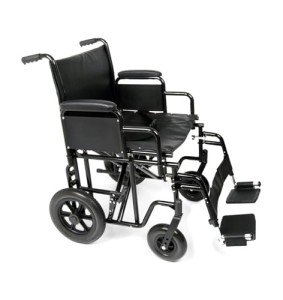Extra Wide Bariatric Wheelchair With 24" Seat

Frame
Wheelchairs are generally made in a standard width of 16" (narrow adult), 18" (standard grownup) or 20" (large grownup). However, some wheelchair users need a seat width larger than these standards. These additional broad bariatric wheelchairs are generally fitted by a professional and based upon the user's measurements.
In order to get the most comfy and safe ride for travelers, it is very important that wheelchairs are appropriately sized. This implies that the wheelchair must have the ability to accommodate the user's size while being able to navigate in tight areas. This is why BriteLift offers customized cars to transport wheelchair travelers. This consists of vans that can securely drive and navigate big wheelchairs, permitting them to feel safe and comfortable in every trip. This is the only way to supply the most efficient transport for wheelchair passengers.
Seat
Bariatric wheelchairs are larger than standard wheelchairs and are created to accommodate individuals who are heavier or larger. This additional large bariatric wheelchair from Medline includes a 24" seat and a carbon steel frame with rust- and chip-resistant chrome plating. The wheelchair has tool-free push-button adjustable footrests and easy-to-clean vinyl upholstery. It can support approximately 500 lbs.
When picking the right wheelchair width, it is very important to measure the user sitting typically on a flat surface across their largest part of the lap which is generally their hips. It is also suggested that you use a yardstick instead of a measuring tape as it tends to provide a more accurate measurement. If inquiry will be wearing a winter coat then an extra 2" ought to be included to the measurement of their seat width.
Weight Capacity
A bariatric wheelchair is normally bigger and much heavier than standard wheelchairs. This is why they require more careful maneuvering. Drivers need to be trained in managing these passengers. Moreover, automobiles require to have adequate space for these chairs in addition to ramps and wheelchair lifts. In addition, they need to know how to schedule these trips in advance.
When selecting the chair width, it is important to determine the user's widest point in the seat, which is normally the hips. Lots of wheelchair manufacturers likewise provide a yardstick that can be used to aid with this measurement. When measuring an individual's width, it is best to take the measurement straight across and not cover the tape around their hips which can offer an incorrect reading.
Sometimes, the best part of a person's thighs may be larger than their hips so this ought to be taken into factor to consider when picking the chair width. In these circumstances, it is often necessary to add an additional 2" to the chair width.
In basic, the weight capacity of a bariatric wheelchair need to not be surpassed under any scenarios or major injury may result. When using the chair, constantly be sure that it is on a steady and level surface area with front casters pointing forward and wheel locks engaged. In addition, never lean or move the center of gravity while being in the chair.
